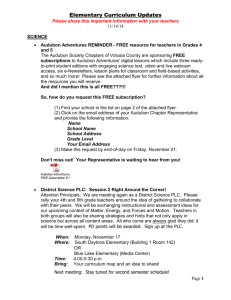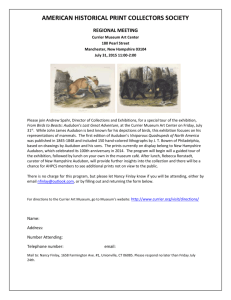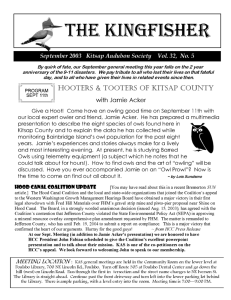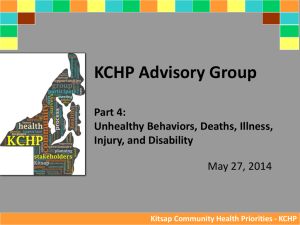The Kingfisher - Kitsap Audubon Society
advertisement
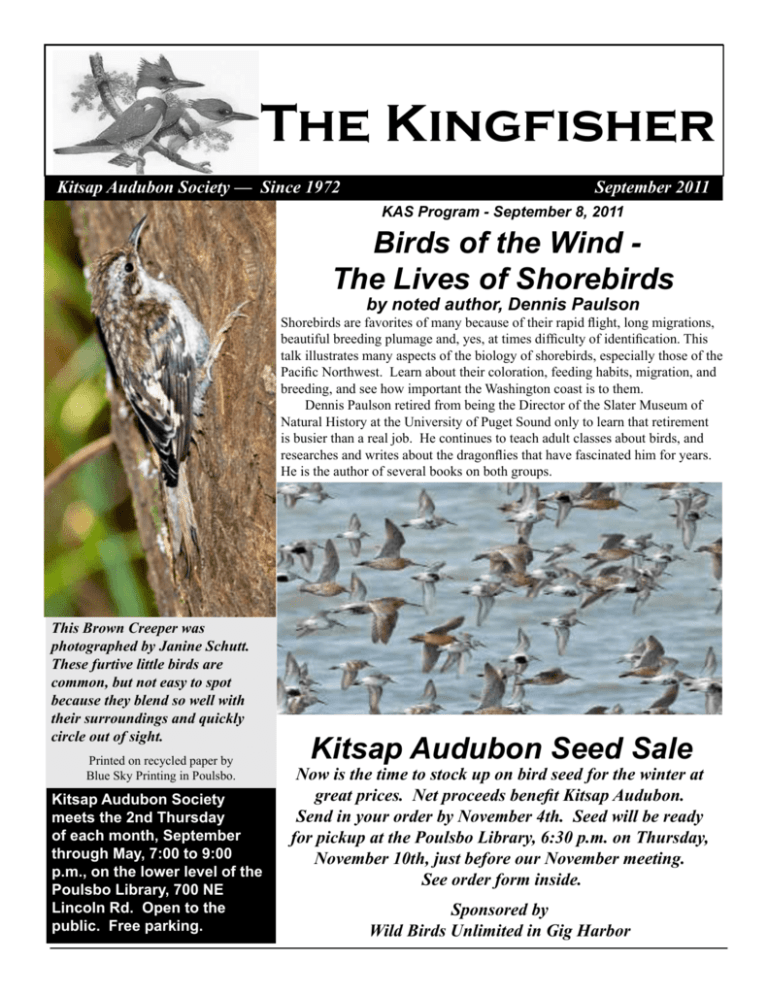
The Kingfisher Kitsap Audubon Society — Since 1972 September 2011 KAS Program - September 8, 2011 Birds of the Wind The Lives of Shorebirds by noted author, Dennis Paulson Shorebirds are favorites of many because of their rapid flight, long migrations, beautiful breeding plumage and, yes, at times difficulty of identification. This talk illustrates many aspects of the biology of shorebirds, especially those of the Pacific Northwest. Learn about their coloration, feeding habits, migration, and breeding, and see how important the Washington coast is to them. Dennis Paulson retired from being the Director of the Slater Museum of Natural History at the University of Puget Sound only to learn that retirement is busier than a real job. He continues to teach adult classes about birds, and researches and writes about the dragonflies that have fascinated him for years. He is the author of several books on both groups. This Brown Creeper was photographed by Janine Schutt. These furtive little birds are common, but not easy to spot because they blend so well with their surroundings and quickly circle out of sight. Printed on recycled paper by Blue Sky Printing in Poulsbo. Kitsap Audubon Society meets the 2nd Thursday of each month, September through May, 7:00 to 9:00 p.m., on the lower level of the Poulsbo Library, 700 NE Lincoln Rd. Open to the public. Free parking. Kitsap Audubon Seed Sale Now is the time to stock up on bird seed for the winter at great prices. Net proceeds benefit Kitsap Audubon. Send in your order by November 4th. Seed will be ready for pickup at the Poulsbo Library, 6:30 p.m. on Thursday, November 10th, just before our November meeting. See order form inside. Sponsored by Wild Birds Unlimited in Gig Harbor KITSAP AUDUBON SOCIETY President: Jim Ullrich, 360-692-4869 (1253-851-2575 store), jimullrich@gmail.com Vice President: Janine Schutt, jeschutt@ hotmail.com; 360-830-4446 Treasurer: Dee Finkbeiner, 360-895-0374, finchlegs@wavecable.com Secretary: Rosemary Courtright, 360-8304405, rosemary@zipcon.com Immediate Past Pres.: Judy Willott, 206842-6939, jdwillott@mac.com At-Large Board of Directors: Spring Courtright, programs@ kayakproshop.com Byron Kane, 360-297-2716, bk4all@ centurytel.net Jessica Klinkert, 360-60-551-2647, jklinkert_2000@yahoo.com Sharron Ham, 360-779-5458, shabobham@ comcast.net Sandy Bullock, 360-394-5635, roadrunner1957@comcast.net Gene Bullock, 360-394-5635, genebullock@comcast.net Standing Committee Chairs Conservation/Kingfisher/Christmas Bird Count: Gene Bullock, 360-3945635, genebullock@comcast.net Education: Fay Linger, 360-297-3855, ernieandfay@centurytel.net Education Vice Chair, Randena Walsh Field Trips: John Finkbeiner, 360-895-0374, finchlegs@wavecable.com Field Trip Vice Chair: Spring Courtright Hospitality: Milly Bellemere & Bob Schumacher, 360-830-4231, rbellemere@wavecable.com Programs: Vic Ulsh, 360-479-6900, vic@ bradleyscottinc.com Publicity: Barbara Wilhite, 360-6928180, naturesvoice@wavecable.com Refreshment Chair: Jessica Klinkert Membership Administrator: Sara Kane, 360297-2716, bk4all@centurytel.net Purple Martins: Sandy Pavey, 360-9300807, s4sandy@earthlink.net Paul Carson, 360-779-2612, Raffle Coordinators: Dawn & Hans Hansen, 360-830-5222 Wildlife Sightings: Joan Carson, joanpcarson@comcast.net or 360-779-2612 Scholarship Committee: Sandy Bullock Webmaster Mike Szerlog, 360-297-6794, szerlog@ comcast.net, www.kitsapaudubon.org Kingfisher Editor Gene Bullock, 360-394-5635, genebullock@comcast.net, Glenn Anderson — 1924-2011 Donations are being accepted for a memorial scholarship fund in Glenn’s name. We were saddened to learn that Glenn Anderson passed away on July 5 at the age of 86. He and his wife Marian were dedicated members of Kitsap Audubon for many years. Glenn received the 2006 Kingfisher Award for his years of outstanding service in such roles as membership chair. They are fondly remembered by everyone who knew and worked with them. Glenn was a well known biology teacher at Bremerton High School in the 1950’s. He began his teaching career at Bremerton High School in 1954, and taught biology and zoology there until 1960. He was awarded his Doctor of Philosophy degree in zoology by Oregon State University in 1964. That fall he began teaching at Northern Arizona University in Flagstaff, and rapidly advanced to professor and assistant chairman of the Department of Biology. On his retirement in 1989 he was named Emeritus Professor of Biology. He was born November 30, 1924, in Mount Vernon, Washington, to Eleanor and Arthur Anderson and grew up on the family farm near LaConner. He graduated from LaConner High School with honors in 1943, in the middle of World War II. Immediately after graduation he entered the U.S. Army. He served in Europe in the 14th Armored Division of the Seventh Army, saw action in battles in eastern France and in Germany, before being wounded near Frankfurt, Germany. For his service he was awarded the Purple Heart and the Bronze Star for heroism. He earned his Bachelor of Science degree and Master of Science of Teaching Biological Science from Washington State University. In November, 1949, he married Marian Meyer in Seattle, and they began a marriage that lasted 61 years, until his death. In 1996 Glenn and Marian returned to the northwest to enjoy their retirement, living for several years in Port Orchard, and later in Bremerton. In 2010, they moved to Medford, Oregon because of increasingly serious health problems. He is survived by his wife Marian of Medford, Oregon,, his sister Dorothy Clegg of Seattle, his brother Dr. Keith Anderson of Ashland, Oregon, and his niece Cynthia Clegg of Mukilteo. ACOW meets October 8 The Washington Audubon Council of Washington will meet Saturday, October 8, in Moses Lake. All are welcome to attend and help determine the future of Washington Audubon. Should we have a state office? What should the purpose of that office be? Coordinator, lobbyist, scientist? Who pays? Lots of important questions to consider. We need everyone to provide input. This will be a one day event starting at 9:00 am. For registration and more details as they become available, please check the Spokane Audubon website (www.spokaneaudubon.org). From the President—Jim Ullrich Welcome to all Kitsap Audubon members and our new calendar year 2011/12. I want to personally thank Judy Willott, who served for a full two years as president and leader of our great KAS organization. She and her board accomplished a great deal since assuming the job in July 2009! Their many accomplishments included some of the best programs we have had at our general meetings in years. And now we are wrapping up for the upcoming publication of the last Washington State Birding Trail Map for the Puget Sound Loop. You may have seen Judy in a SeattleTtimes feature a few months ago, while out on an expedition identifying Kitsap appropriate Birding sites to be featured in the new map. I have to thank her sidekick, Don Willott, one of the many professional photographers we have on staff, for his loyal support and the many photographs he has taken at meetings and on the trail. Also leading the charge as our Conservation Chair, Gene Bullock is working to protect environmentally sensitive areas from aggressive growth minded companies and individuals. And last, very big thank you’s to all who have agreed to continue serving our great organization in the various Standing Committee chairs, from Joan Carson who has served in many capacities from the very Kitsap Audubon - 1972-73 Joan Carson was one of the founders of Kitsap Audubon Society, which began 39 years ago. This is the first installment of a series of articles she is writing on the history of Kitsap Audubon. The first organizational meeting for KAS was held November 3, 1972, in the home of Paul and Joan Carson. A public meeting was held December 7 at the Poulsbo Marine Center (where Liberty Bay Marina is now located). Seventy-five people attended and a slate of temporary officers was elected. They were: President, Joan Carson; Secretary, Ray Coleburg and Treasurer, Jean Doar. Acting committee chairmen were also appointed. Membership, Zane Lumbley; Conservation, Steve Wilson; Field Trips, Ann Sleight; Publicity, Sylvia Nelson; Refreshments, Rosemary Doar; coeditors Kitsap Kingfisher, Harold Kelley and Dale Spoor. On January 18, the first regular meeting was held and the first permanent slate of officers elected. President, Ray Coleburg; 1st V.P., Dale Spoor; 2nd V.P., Jack Nelson; Secretary, Charlotte Coleburg; Treasurer, Jean Doar. Committee chairs remained the same with the exception of the Kingfisher Editor. Joan Carson was appointed to that position. Carroll Rieck of the Department of Wildlife was the speaker and spoke on the Nongame Program and the drive to have it funded by personalized license plates. Ann Sleight’s field trip schedule began with a trip to Dungeness Spit led by Paul and Joan Carson and a trip to Scout Lake led by Conservation Chair, Steve Wilson. By February of first day that Kitsap Audubon was formed, to everyone else who works so diligently in accomplishing so much for our Kitsap Community of environmentalists. Special congratulations to three brand new board members: Janine Schutt, Vice President; Jessica Klinkert, At Large Member; and Spring Courtright, At Large Member. This is going to be a very exciting year, and my first request is to ask all of you to share the exciting things we do at KAS by passing on your Kingfisher to friends and family. Consider giving gift memberships to a family member or friend for their birthday or the upcoming holiday season. Also, please consider stepping forward, as have Spring, Janine and Jessica, to serve on various KAS committees. Just email or call me with your questions on how to serve. (Home) 360-692-4869 (Cell) 253-9708612 or email jimullrich@gmail.com. See you Thursday evening, September 8th, for a great program! By Joan Carson that year, the group was approved to request separate chapter status. Thirtyfive NEW members had joined. The original membership list had been mostly transfers from Seattle and Tacoma Audubon. The next step was to write our own constitution. The February program was by Dr. Richard Olendorff, Professor of Ornithology at Olympic College, speaking on his research on golden eagles. Dale Spoor introduced the recycling effort being started on Bainbridge Island. Sharon Shrader, representing the Citizens for Responsible Development of the Port of Brownsville, gave a report to those present on the proposed expansion of the Brownsville Marina. March field trips were to the Rawson Grant (Nature Conservancy Reserve) in Hansville, led by Dr. Rawson, Continued on Page 9 Field Trip Guidelines John Finkbeiner Field Trip Chair 360-895-0374 finchlegs@wavecable.com Field trip guidelines can vary according to leader preferences and the nature of the trip. Trip leaders try to keep some slots open to new people. 1. Trips are limited to 12 participants unless otherwise specified. 2. Children 12 and under are welcome only on designated family trips or with permission of the leader. All children should be accompanied by a parent or adult designated by the parent. 3. Some receive their Kingfisher earlier than others (email versus regular mail, for example). To be fair, please do not call for a reservation before the date specified by the leader. 4. If the weather is questionable, call the leader the morning of the trip to confirm that it has not been cancelled. If you must cancel, do so as soon as possible because others may be on a waiting list. 5. Dress for the weather. Please refrain from wearing white or bright colored clothing. 6. Bring binoculars and cash for ridesharing (see below), and bring a lunch for all day trips. Field Trip Transportation Carpooling is encouraged to reduce costs and limit the parking spaces required. Passengers are asked to share expenses with the driver. A contribution to the driver of $5 for shorter trips and $10 for overnight trips is suggested, with any additional expenses, such as tolls, parking fees, etc. divided equally among driver and passengers. On longer trips, shared expenses may be based on mileage. Field Trips Celebrate Urban Birds with the Great Penininsula Conservancy and Friends of Miller Bay, Saturday, September 17, 10 a.m. to 2 p.m., Cowling Creek Center, 20325 Miller Bay Rd. NE, Suquamish. Birding walks and hands-on craft activities for kids of all ages. www.greatpeninsula.org Point-No-Point - Sat. 9/24/11 - Fay Linger, Leader. Call 360-297-3855. This is a half day trip. We should see some interesting fall birds. We’ll also check nearby areas. Meet at Point-no-Point at 8:30 a.m. San Juan Islands, October 3-5, 2011. Join the Olympic Peninsula Audubon Society for a three-day wildlife cruise through the San Juan Archipelago. Cruise to Roche Harbor Resort and San Juan Island, whale-watching along the way. Picnic on Sucia Island and cruise home via Deception Pass. Call 360-681-4076 or email rcoffice@olympus,net. Details at: www. olympicpeninsulaaudubon.org Field Trip Reports Skagit and Samish Flats Field Trip – March 5th 2011. Leader Fay Linger. Nine KAS birders spent a lovely spring day birding in Skagit County having postponed the outing due to heavy snow the previous week. At the Headquarters Unit of the Skagit Game Range we spent 15 minutes watching the visiting Black Phoebe fly-catch along some small alders in the slough. This was a target bird that was spotted by Mary Bullitt. In the same area were Northern Harriers, Northern Pintails, Hooded Mergansers, Blackcapped Chickadees, Bushtits, Yellow-rumped Warblers, Golden-crowned and White-crowned Sparrows and a great Bewick’s Wren. Trumpeter Swans were along I-5 and Tundra Swans were at our lunch stop behind the Farmhouse Restaurant. Excellent scope views at both locations. A good start to the day. Snow Geese were harder to come by. Hundreds flew over us heading south as we drove onto Fir Island and there were a few hundred in a field out of easy driving access. At Indian Slough after lunch were Green-winged Teal, Northern Harriers, Great Blue Herons and far into a field a scope view of a fine Peregrine Falcon. The town of Bayview turned up a Eurasian CollaredDove another target bird again spotted by Mary Bullitt! The drive to Edison yielded many, many Northern Harriers, Bald Eagles, Red-tailed Hawks and Great Blue Herons. And from a parking lot in downtown Edison we scoped a wonderful Merlin which was another find by Mary. As the afternoon was coming to a close the time was upon us to drive to the “Samish West 90” where we were treated to the sunset show of the Short-eared Owls This was an unforgettable scene with at least a dozen owls hunting and jousting with each other before our very eyes and more across the fields at a distance. The day’s total was 53 species seen. Theler Wetlands - 5/7/11 - John Finkbeiner, Leader. We had no rain, but higher winds cut our land birds tally. We did see and hear several Common Yellow Throats and had a good look at an Orange Crowned Warbler. Four swallow species were found along the boardwalk. At the Union River we had the best bird of the day when four Wimbrels flew overhead. These are rare in Mason and Kitsap Counties. Also heard a Lesser Yellowlegs and Virginia Rail. Caspian Terns were flying up and down the river. One of the three White-fronted Geese that spent most of the winter here is still hanging out with the Canada Geese. In total, we had 35 species. A late surprise was a Ruffed Grouse that flew over Hwy. 3 just north of the Bremerton Airport. Kitsap Audubon Fall Seed Sale 2011 Order Form Name____________________________ Phone No.______________ Address __________________________ City ___________________ Zip Code__________ Email _________________________________ Bird Seed Price No. of Bags Amount Northwest Choice Blend $23.99 x ____ ________ Northwest No-Mess Blend $28.99 x ____ ________ WBU Finch Blend (half Nyjer/half chips) $26.99 x ____ ________ WBU Med Sun Chips $28.99 x ____ ________ WBU Nyjer $28.99 x ____ ________ WBU Premium Black Oil $18.99 x ____ ________ Sunflower WBU Squirrel Nut Treat $33.99 x ____ ________ Sub Total Sales Tax Total Sale x 8.6% = ________ ________ ________ Deadline for orders, Friday, November 4th, 2011 Delivery November 10th, Poulsbo Library, 6:30 p.m. before KAS meeting Make checks payable to KAS. Mail order form with payment to: Kitsap Audubon P.O. Box 961 Poulsbo WA 98370 Net proceeds to benefit the Kitsap Audubon Society Sponsored by Wild Birds Unlimited of Gig Harbor Wildlife Sightings by Joan Carson (joanpcarson@comcast.net or phone 360-779-2612) Spring and most of summer may have been colder than normal but the migration and subsequent bird reports were the most interesting in many years. Will try to get as many as possible in this issue and the remainder will follow in the October Kingfisher. April 16, Ian Paulsen, FOS osprey, Manitou Beach, B.I. 4/17, Gene Bullock, osprey building nest on Poulsbo cell tower. 4/17, Vic & Bonnie Ulsh, FOS yellow-rumped warblers on Clear Creek Trail (Silverdale) & Kitsap Lake boat launch. American kestrel at Clear Creek Trail. 4/18, Barb & Bill Sims, Twin Spits, Hansville, pair of Eurasian collared-doves. 4/21, Carolyn Barry, Driftwood Keys, Hansville, 2 black oystercatchers. 4/22, Stephen Hubbard reported osprey he saw on 4/2 now on nest, Eagle Harbor, B.I. Same nest has had young for at least 4 years. 4/25 Deb Seltzer, Hood Canal near Union, 70 common loons in 2 flocks that eventually merged after calling to each other. 4/25 Kathy Swartz, Yukon Harbor, yellow-rumped warblers, Audubon and Myrtle varieties. Nesting osprey 2 miles from her house. May 1, Bob Wiltermood, Ruby Creek Marsh, South Kitsap, saw first great horned owl baby in the nest he discovered in April. 5/4, Ian Paulsen birding B.I., 2 Pacific-slope flycatchers, 1 black-throated gray warbler, close look brown creeper, 9 least sandpipers, 3 horned grebes (breeding plumage). 5/5, Susan & Scott Ford had first pair of Western bluebirds move into one of the boxes on the South Kitsap bluebird trail. 5/7, John Finkbeiner, Theler Wetlands, 4 (rare) whimbrel. 5/8, Ian Bentryn, Home Depot (Silverdale) parking lot, raven and red-tailed hawk having an argument. Crow joined the fight and red-tail got away. He also saw Wildlife Sightings—Joan Carson 2 peregrine falcons flying over the Suquamish side of the Agate Pass Bridge - and a coyote in his yard about 9 PM. 5/8, Ian Paulsen, Suyematsu’s Farm, B.I., a chipping sparrow and a golden-crowned plus 2-3 Lincoln’s. Female hooded merganser on pond. 5/8, Jamie Acker, B.I., 46 species in his yard in one day. Included 5 woodpecker species, 7 sparrow species including a white-throated and a Lincoln’s. Also evening grosbeaks. 5/9, Jeanne Snouwaert, Lemolo, a white-throated sparrow in with the golden-crowned sparrows for about a week. Pileated woodpecker on feeder. 5/9, Ian Paulsen, Suyematsu’s Farm, B.I., 1 American pipit, 1 California quail. Reported that Victoria Irwin had a barn owl off Valley Road, B.I., on the 7th. He also reported that there are now ten bald eagle nests on the Island. 5/10, Brad Waggoner, Schel-chelb Estuary, B.I., solitary sandpiper and 2 yellow warblers. 5/12, Brad Waggoner, at the Estuary, a Swainson’s hawk, an Island first, and according to Ian Paulsen is #257 on the Island Bird Checklist. 5/13, Sabo Family, mile east of Bangor Main Gate, a male lazuli bunting at feeders. 5/14, Lee Robinson, B.I., a male lazuli bunting in her yard. Ian joined her and they also had Western tanagers and black-headed grosbeaks. Ian noted this was fitting for International Migratory Bird Day. 5/14, Karen Salsbury, B.I., FOS olive-sided flycatcher. 5/14, Deb Rudnick, B.I., flock of evening grosbeaks. 5/14, Brad W., at Estuary had dusky flycatcher, #258 for the Island; Later, Brad, Ian, George Gerdts, Mary Ann Rossing had Vaux’s swifts, yellow-rumped, orangecrowned and Wilson’s warblers; male Western Tanager; and warbling vireo. That morning, at Suyematsu’s Farm, Brad had two Western kingbirds, 1 Eurasian collared-dove, a male lazuli bunting and 2 California quail. 5/15, Beryle Shore, Eagledale, B.I., had wood ducks move into nesting boxes her neighbors installed. First time they have stayed to nest. 5/16, Kathy Swartz, Yukon Harbor, sent several photos of eagle nest with young being fed. 5/16, Gene & Linda Daniels, Keyport, A Wilson’s warbler and also watched an encounter between an eagle and 2 Canada geese. Geese chased eagle away. 5/16, Rita Weber, East Bremerton, a male lazuli bunting on her deck railing. 5/17, Kathy Swartz, flock of 15 evening grosbeaks. 5/24, John & Claudia McDonald, Lake Symington, evening grosbeaks. 5/26, Brad Waggoner, Battle Point Park, B.I., a “female-type” pine grosbeak. (Waiting to have this confirmed.) 5/27, Charlotte Coleburg, 2 Western tanagers and calling cedar waxwings. 5/29, Lindsay Sanford and her father at Bloedel Reserve, B.I., a palm warbler. Ian said this is 2nd sighting for the Island. 5/27, Fay Linger, Indianola, flock of at least 34 evening grosbeaks. 5/30, Joan Maggert, Kitsap Lake, a lazuli bunting. 5/29, Carson yard, Poulsbo, a river otter walking up their sidewalk! June 4, Kathy Swartz, on Sedgewick Rd., near Longlake Rd., intersection, a rose-breasted grosbeak. June 11, Susan Ford (PSBRP) reported that 5 of the 6 Western bluebird eggs had hatched! Will start with June’s reports next month and hope we catch up. Great reporting! Photo: Long-time member Bob Wildermood rescued and released this Great Horned Owlet in his restored wetland preserve. New Waterfowl Rehab Enclosure By Kol Medina, West Sound Wildlife Shelter Courtesy of the Bainbridge Review “Ouch!” “Now don’t spit out those fish again.” “Gosh dangit, that hurt!” I’m standing in our new waterfowl enclosure watching Mike Pratt, our Director of Wildlife Services, and Lynne Weber, our Wildlife Rehabilitation Specialist, try to feed fish to a feisty juvenile cormorant. The cormorant’s body is wrapped in a white towel, and Lynne is holding on tight as the cormorant’s head and about 10 inches of sleek, black neck dance around like a cobra about to strike. And strike it does. Wham! “Stop it,” Mike says as he quickly dislodges his finger from the cormorant’s sharp beak. Mike gains an edge in the struggle, forces the cormorant’s beak open, and begins stuffing herring down its throat (just like the cormorant’s mother does). One little herring down the hatch. Now a second. Mike stops at six herring and starts to stroke the cormorant’s neck to stimulate swallowing. But the cormorant is having none of it. With a shake of its head and a loud “blaahh,” all six herring come flying out of the cormorant’s mouth and slap down on the deck. (Okay, there was no “blaahh” sound, but you get the picture.) It’s another morning at West Sound Wildlife Shelter. But this morning is different because our new waterfowl enclosure is open. This amazing facility, funded entirely by donations from wonderful, caring people, is only the second facility of its kind in the state. This facility will help us save the lives of countless waterfowl in the coming decades – ducks, cormorants, gulls, herons, loons, geese, auklets, and the other species that grace the lakes, shores, and Sound all around us. This new facility has some special magic, a deep resonance with my soul. It’s completely open to the elements. The “roof” and “walls” are welded wire. The water in the six eight-foot diameter pools – each set in a deck and separated from the others – is constantly being cleaned by a ridiculously complicated filtration system. Every day I spend time in the enclosure, and each day I come away with my mood improved and a brighter outlook on life. I’m not sure why. Is it knowing that innocent, feathered bundles of life will be saved here? Is it the constant sound of running water? Is it the unexpected beauty of the wire and wood construction? Is it the cute duck heads that tilt and look up at me? I suppose it’s all of this. In addition to two cormorants, there are also 15 mallard ducks in the enclosure right now. They are all orphans, having lost their parents to cars, dogs, or some other tragedy. Three of them were discovered by a woman who saw a distraught mallard mother circling around a storm drain on the Winslow Green. It turns out that three of the mother’s ducklings had fallen through the grate into the drain. By the time we rescued the ducklings, their mother had been scared off by the crowd of humans gathered around. So we had to bring the duckies back here to raise. I wish their mother had been able to see them when we moved them out to the waterfowl enclosure. When they were old enough to go outside, we put them in a kitty carrier and took them out to the enclosure. As soon as we opened the carrier door, they waddled out as fast as their clunky webbed feet could take them. Their immense joy at suddenly being in a big pool of water was instantly recognizable as they peeped and chirped, swam and dove, and splashed water about like kids in a swimming pool. The juvenile cormorant just came in last night, having been found stunned on a couple’s deck. He must have been quite shocked this morning to find Mike trying to stuff herring down his throat. He appears to be in fine shape. After a day or two of monitoring (and lots of free fish!), he’ll probably be released. In the meantime, though, his fight with Mike and Lynne continues. “Yikes!” “Stop biting me.” “Now keep those fish in there!” As I walk away I hear a loud “blaahhh,” the sounds of wet fish smacking the deck, and Mike saying, “Now come on!” Photo courtesy of Dottie Tilson Kitsap Audubon - 1972-73 Continued from Page 3 and Zane Lumbley led a trip to Fort Flagler on the Olympic Peninsula. The March program was a Presentation of the work and plans of the Metropolitan Development Council. They identified goals and objectives for Sinclair and Dyes Inlets, Port Washington Narrows and a public wharf-marina complex in Bremerton. By April, KAS was working to establish a wild bird clinic. It later was named the Wild Bird Rescue so as not to use the same name Seattle Audubon had for its clinic. Jack Eads, Port Orchard, was the director and Elinor Thompson the chairman. The April issue of the Kingfisher ran an article by Jean Schuette on the “Care & Feeding of Young and Injured Birds.” Jim and Marg Galbraith also wrote an article, “Where’s the Best Birding in Kitsap County?” April’s Program was given by Andy Driscoll, Director of the Marine Science Center. It was on marine life both at the Center and in local waters. May’s Program was by Conservation Chair, Steve Wilson. He spoke on clear cutting practices in the forests of the state. Ann Sleight encouraged members to attend the annual Audubon Campout at Wenas Creek near Yakima. Chapters from all over the state attended the 3-day event. A progress report on the status of the Nongame License Plate Program noted that an effort to override Governor Dan Evans’ veto failed but the measure would be on the November ballot as Referendum 33. Membership Chair, Zane Lumbley advised the Board that KAS now had 155 members. The Constitution and By-laws Committee under the direction of Jack Nelson announced its work completed and KAS was about to gain independent chapter status. As we took a summer break until the following September, Kitsap County was facing the advent of Trident and Congress was working on Senate Bill 1104. Sponsored by Senator Philip Hart (D-Michigan), the bill was before the Senate Commerce Committee, chaired by Senator Warren Magnuson (D-Washington). The Sierra Club and other supporters of this bill were asking KAS members to write letters to their senators endorsing the passage of the Environmental Protection Act of 1973, “which established for the first time anywhere that environmental quality is a basic right of every citizen rather than a privilege bestowed by government.” State’s Fifth Wolf Pack Confirmed Washington’s fifth gray wolf pack has been confirmed in northeast Stevens County. Earlier this month, Washington Department of Fish and Wildlife (WDFW) biologists caught, marked with an ear tag and released a 2-month-old wolf pup from the pack. Biologists have since been trying to capture one of the pack’s breeding adult wolves to radio-collar it for monitoring. The effort to document the pack began after local ranchers reported observing three wolf pups and hearing howling in late June. The pack is believed to include a breeding-age male and female and at least three pups. The group has been named the Smackout Pack, in reference to geographic features in the area. The Lookout Pack, confirmed in Okanogan and Chelan counties in 2008, was Washington’s first documented resident gray wolf pack since a breeding population of wolves was extirpated from the state in the 1930s. Two more packs have been documented in Pend Oreille County- the Diamond Pack was confirmed in 2009, and the Salmo Pack was confirmed in 2010. This summer, the state’s fourth documented pack-dubbed the Teanaway Pack- was confirmed in Kittitas County. DNA analysis of that pack’s adult female wolf indicated she is likely a recent descendant of the Lookout Pack. The gray wolf (Canis lupus ) is protected throughout Washington as a state endangered species. In the western two-thirds of Washington, the species is also federally protected under the Endangered Species Act (ESA). It is illegal to harm or harass a federal- or state-protected endangered species. WDFW has been working since 2007 to develop a wolf conservation and management plan in anticipation of wolves re-entering Washington from other states or Canada. A Final EIS/recommended plan-which was developed with a 17-member citizen group and included extensive public review and scientific peer review-will be presented to the Washington Fish and Wildlife Commission in a special public meeting Aug. 4 in Olympia. Additional public workshops on the proposed plan are scheduled later this summer and in the fall. “Wolves are re-establishing here on their own,” said Nate Pamplin, who heads WDFW’s Wildlife Program. “The confirmation of additional breeding wolf packs moves us closer to achieving a sustainable population, and also highlights the need to finalize a state wolf plan that sets recovery targets and management tools to address livestock and ungulate conflicts.” For more information on the draft plan and all Washington wolf packs, see http://wdfw.wa.gov/conservation/ gray_wolf/ . Wolf sightings or activity should be reported through the joint federalstate toll-free wolf reporting hotline at 1(888) 584-9038. Joint federal-state Wolf Response Guidelines, including agency staff contact information, are available at http://wdfw.wa.gov/ conservation/gray_wolf/contacts.html . Kitsap Audubon Society P.O. Box 961, Poulsbo, WA 98370 Address Service Requested NONPROFIT ORG US POSTAGE PAID SILVERDALE WA PERMIT NO. 111 The Kingfisher is the newsletter of the Kitsap Audubon Society P.O. Box 961, Poulsbo, WA 98370. It is published eight times a year, September to May. Submissions from readers are welcome. We reserve the right to edit for space, grammar or legal reasons. Email text or photographs to genebullock@comcast.net or mail to Gene Bullock, 1968 NE Lind Ct., Poulsbo WA 98370. Our deadline is the 15th of the preceding month. To receive your Kingfisher via email and save us the expense of printing and mailing, send your request to genebullock@comcast.net. KITSAP AUDUBON SOCIETY — MEMBERSHIP RENEWAL Make check payable to KAS and maill to KAS, PO Box 961, Poulsbo, WA 98370 Name ________________________________________________ Phone _______________________________ Address ____________________________________________________________________________________ City ______________________________________________________ State __________ Zip ______________ Email Address: _______________________________________________________________________________ ______Check here to receive your Kingfisher newsletter via email and save us the expense of printing and mailing. SELECT Category of Membership: ______Individual Annual Membership $15 ______Family Annual Membership $25 ______Contributing Annual Membership $50 ______Supporting Annual Membership $100 ______Individual LIFE Membership $300 ______Family LIFE Membership $500 ______Sustaining Annual Membership $75 (Contact KAS Treasurer for LIFE Membership payment options) $ __________________Additional donation for scholarships and/or Audubon Adventures (designate). The Kitsap Audubon Society is a 501(c)3 nonprofit organization. Donations are tax deductible. The mission of the Kitsap Audubon Society is to preserve the natural world through education, environmental study and habitat protection, and to promote awareness and enjoyment of local and regional natural areas. Visit our website at www.kitsapaudubon.org


